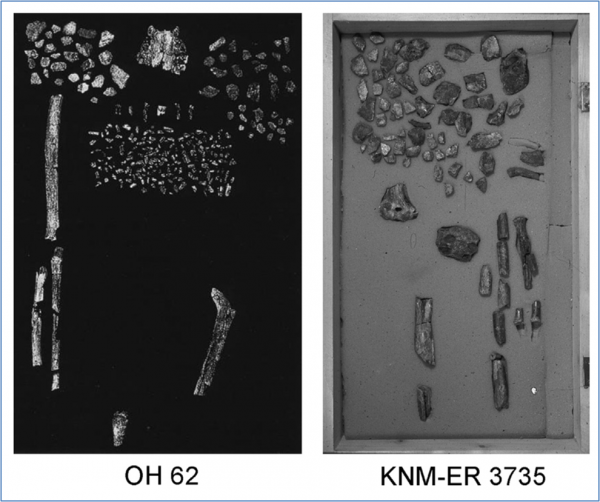No products in the cart.
Return To ShopHomo habilis: Early Human Ancestor?
Natural history museums everywhere line-up ape-to-human icons that supposedly show humans evolving from ape-like creatures over millions of years. After the icon named “Lucy,” which evolutionists place in the “3 to 4 million years ago” time slot, the next ape-to-human icon is Homo habilis. This creature fits into evolution’s timeline about 1.4 to 2.4 million years ago, taking the slot right before Homo erectus supposedly appears on the scene.[i]
Before looking at this icon, let’s consider something very interesting about this stage in evolution’s timeline. According to the current theory of human evolution, the time slot between 2 and 3 million years ago has almost no fossil evidence to support it. A National Geographic article puts it this way: “Fossils attributed to Homo in the period two to three million years ago are exceedingly rare.” Quoting Dr. Kimbel, director of the Institute of Human Origins at Arizona State University, the article states: “You could put them all into a small shoe box and still have room for a good pair of shoes.”[ii]
Figure 25. All the fossils that supposedly show the ape-to-human evolution in the 2–3 million-year timeslot can fit into a shoebox, with room left for the shoes.
It’s hard to imagine evolution pressing ahead for one million years with only a shoebox of bones to show for it. That’s a long time to go without any supposed “transitions” between apes to humans, don’t you think?
Charles Darwin even said “… as by evolution theory, innumerable transitional forms must have existed, why do we not find them embedded in countless numbers in the crust of the Earth?” He also said, “Why is not every geological formation and every stratum full of such intermediate links? Geology assuredly does not reveal any such finely graduated organic chain; and this is the most obvious and serious objection which can be urged against the theory.” Darwin expected there would be more evidence for his theory in the future, but after more than 150 years of digging since his time, the fossil record of supposed human evolution is still very, very scant. In fact, according to Dr. Tattersall, the Curator of the Anthropology Department at the American Museum of Natural History, the entire ape-to-human fossil record could “fit into the back of a pickup truck if you didn’t mind how much you jumbled everything up.”
Inventing a new icon, Homo habilis, hasn’t helped with this scarcity problem at all. In fact, did you know that they’ve never even discovered a Homo habilis skeleton? This species was invented to categorize bone pieces—which total less than 100 small specimens[iii]—into an ape-to-human transitional form they believe was becoming more handy with stone tools,[iv] hence the name “handy man.” While they’ve never found anything even close to a complete Homo habilis creature, that hasn’t stopped them from displaying complete human-looking versions of it in museums and textbooks everywhere (see Figure 26 for examples).

In fact, the best set of bones they have for this icon, which they refer to as the official “type specimen”[vi] consists of just a jawbone with 13 teeth, a molar, a couple of skull fragments, and 21 finger, hand, and wrist bones.[vii]

These bone pieces were collected from a widely excavated area that was mixed with bones from cow, pig, horse, tortoise, catfish, and bird bones. After further study, however, this “defining specimen” turned out to be a mixture of bones from different animals, with 6 of the 21 finger bones belonging to a different creature, one of the finger bones mistaken for a vertebral fragment, and two others belonging to a monkey.
While the limited fossils belonging to this new Homo habilis icon were found with stone tools, evolutionists cannot be certain whether the stone tools were used by Homo habilis, or used on Homo habilis by humans. They were in fact found broken apart and scattered over a 1,300 square foot area just like all the other butchered animal bones in the region. It sure seems like humans were eating these creatures along with a lot of other types of animals. Think about the stone tools they found for a moment. The tools they discovered included choppers, polyhedrons, discoids, and many small tools like scrapers.[ix]

The problem for evolutionists is that most of these tools were made from rocks that were quarried miles away from where they were used to butcher the dozens of animals found at the site, where thousands of animal bones were found pulled apart and unattached. Whoever used these tools knew what they were doing because they were all hand-sized and most were made from a certain type of rock called quartzite, which can be flaked to a razor-like edge. Your average person today would have a really hard time making these tools! After identifying the right kind of rock, the rock has to be shaped using percussion and pressure tools, such as pointed hammerstones and cylindrical hammers (sometimes long bones). Plus, they would need to know how to make different types of tools for the various steps of removing food sources from animals, like meat and bone marrow.
But the clues don’t end with stone tools. The evidence that humans were actually the inhabitants of this site is also confirmed by a 12-foot circular foundation[xi] made of lava stones for a hut shelter they found in the same archeological bed where Homo habilis bones were found.

Mary Leakey even described this circular stone foundation as having a “striking similarity” to the dome-shaped hut shelters still made today by nomadic people in the same area and included this photo in her book covering Homo habilis.

The case for human evolution even worsens when considering that they actually found the stone circle in a layer beneath[xiv] Homo habilis bones! Now that’s not faring well for the theory of evolution because whoever was there working with tools and building huts was on the scene before Homo habilis even showed up in the fossil record! This is exactly the opposite of what we would expect if evolution were true.
The 348 animal bones they found scattered around the hut included species from the crocodile, cow, hippo, elephant, horse, tortoise, giraffe, and pig families. And do you know how many they found inside the stone hut circle? Only 11 small fragments, which were mostly toes and teeth. Seems like the leftover pork chops were being thrown outside the living area!

The other clue that this site was being inhabited by humans is that 48 of the 50 pieces of debitage—which are the leftover pieces of rock that get removed when stone tools are made—were found outside the stone hut foundation. Sounds like a human living area, doesn’t it?

According to Mary Leakey, the lead paleo-expert over the site, said that the main evidence that the stone hut foundation was an “artificial” structure—meaning man-made (a term Mary Leakey actually used in her book)—was the six mounds of heaped rocks around the circle that were evidently used for support poles. She also remarked about the disproportionate number of bones and tools they found outside the hut and not inside, along with a two-foot buffer zone around the circle that was mostly clear of tools and bones.[xvii]
The other amazing insight offered by the Leakeys—the very scientists who discovered Homo habilis—is that they found fossil evidence leading them to believe that Australopithecus, Homo habilis, and Homo erectus all lived at the same time![xviii] How is one species supposed to evolve into another over millions of years if the fossil evidence points to them living at the same time? Their position has perplexed many other evolutionary scientists, but they reported what they found: all three species discovered living at the same time.
Now all this data about Homo habilis isn’t holding up the theory of evolution very well. First, we have the issue of the really, really limited data—with fewer than 100 bone pieces ever found.

Then we have the obvious signs of human nomadic tribes living in the area who were setting up camp, living in huts, making specialized hand tools using special rocks found miles away, and butchering and eating animals—including apes—just like people have been doing for thousands of years.
[i] Wood, Bernard. “Fifty Years after Homo habilis.” Nature 508 (April 2, 2014).
[ii] Shreeve, Jamie. “Oldest Human Fossil Found, Redrawing the Family Tree,” National Geographic (March 5, 2015). https://news.nationalgeographic.com/news/2015/03/150304-homo-habilis-evolution-fossil-jaw-ethiopia-olduvai-gorge/. Accessed July 10, 2016. See also: Gibbons, Ann. “Skeletons Present an Exquisite Paleo-Puzzle,” Science 333 (September 9, 2011): 1370–1372 (noting “a significant gap in the fossil record 3 million to 2 million years ago”). Paleoanthropologist William Kimbel at Arizona State University and director of the Institute of Human Origins stated: “There are only a handful of specimens. You could put them all into a small shoe box and still have room for a good pair of shoes,” he says. An upper jaw from Hadar in Ethiopia, found by Kimbel himself, is 2.3 million years old. A lower jaw from Malawi may be 100,000 years older, though the dating is uncertain. Some researchers would include a skull piece from Kenya of about the same age. That’s about it.” See: Fischmann, Josh. “Part Ape, Part Human: A new ancestor emerges from the richest collection of fossil skeletons ever found.” August, 2011. National Geographic. www.nationalgeographic.com/magazine/2011/08/malapa-fossils/. Accessed September 22, 2020.
[iii] Personal communication with Dr. Bernard Wood, University Professor of Human Origins, Center for the Advanced Study of Human Paleobiology, George Washington University, Washington DC: “Most H. habilis fossils are in fossil collections from Olduvai, Koobi Fora, Omo-Shungura, with maybe a few fossils from some sites in South Africa. I would be surprised if there are more than 100 fossils reliably assigned to H. habilis. Some of those may come from the same individual, so my guess is that we know what we do of H. habilis from fewer than 100 individuals, and maybe as few as 50 individuals.
[iv] Wayman, Erin. “The Top Seven Human Evolution Discoveries From Tanzania.” Posted November 19, 2012. Smithsonianmag.com.
www.smithsonianmag.com/science-nature/the-top-seven-human-evolution-discoveries-from-tanzania-133532949/. Accessed September 22, 2020.
[v] Image on left: Smithsonian National Museum of Natural History, “Homo habilis”: https://humanorigins.si.edu/evidence/human-fossils/species/homo-habilis. Accessed September 2, 2015. Image on right: “Homo habilis appearance.” How Humans Evolved. https://howhumanshaveevolved.weebly.com/homo-habilis-appearance.html. Accessed September 22, 2020.
[vi] Smithsonian National Museum of Natural History, “Homo habilis”: https://humanorigins.si.edu/evidence/human-fossils/species/homo-habilis (September 2, 2015).
[vii] Leakey, Mary D. Olduvai Gorge: My search for early man. Collins (1st Edition). January 1, 1979: 56.
[viii] Image credit: www.sciencesource.com
[ix] Leakey, 1979, p. 92.
[x] Leakey, M.D. Olduvai Gorge Excavations in Beds I & II 1960–1963 (Volume 3). New York, NY: Cambridge University Press, 1971: Figure 20.
[xi] Leakey, 1979, p. 55–55; Leakey, Mary. “Report on the excavations at Hyrax Hill, Nakuru, Kenya Colony, 1937–1938.” Transactions of the Royal Society of South Africa. 30 (4) (1943): 1.
[xii] Leakey, 1971, Figure 7.
[xiii] Leakey, 1971, Plate 3, Photograph by MacCalman and Grobbelaar.
[xiv] Leakey, 1971, p. 3, 23, 41 (Figure 19), and Plates 6, 30, 34. Also see Leakey, 1979 (The Stone Circle was found at DK IA, Level 3, Lower Bed I, and several Homo habilis bones were found above this structure).
[xv] Leakey, 1971, Figure 7.
[xvi] Ibid.
[xvii] Leakey, 1979, p. 55.
[xviii] J.T. Robinson and David Pilbeam have maintained the position that Homo habilis is the same as Australopithecus africanus. Louis Leakey (Richard’s father) stated: “I submit that morphologically it is almost impossible to regard Homo habilis as representing a stage between Australopithecus africanus and Homo erectus” (Leakey, Louis S.B. “Homo habilis, Homo erectus, and Australopithecus,” Nature, 209 (1966): 1280–1281. Dr. Leakey also reported that Australopithecus, Homo habilis, and Homo erectus fossils lived at the same time at Olduvai Gorge (see Leakey, 1971, p. 272). In addition, Louis Leakey later reported the contemporaneous existence of Australopithecus, Homo habilis, and Homo erectus fossils at Olduvai Gorge (see Leakey, 1971, 272). Mary Leakey’s discovery of the remains of a circular stone hut at the bottom of Bed I at Olduvai Gorge was found beneath fossils of Homo habilis.
[xix] Associated ilium and femur from Koobi Fora, Kenya, and postcranial diversity in early Homo. OH 62 photo by Donald Johanson. Ward, C.V., Feibel, C.S., Hammond, A.S., Leakey, L.N., Moffett, E.A., Plavcan, J.M., Skinner, M.M., Spoor, F., Leakey, M.G. “Associated ilium and femur from Koobi Fora, Kenya, and postcranial diversity in early Homo.” J Hum Evol 81 (April 2015): 48–67.









